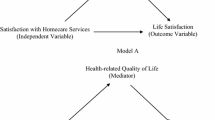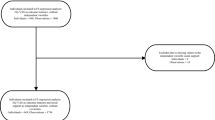Abstract
The general goal of this study consists of analyzing the influence of different types of human services in the quality of life of their nested users. Several multilevel models were proposed to test for significant differences not only in the overall quality of life score, but also in each of the eight core domains. Participants included 11,624 users of social and human services and the assessment quality of life instrument was the GENCAT Scale. Variables that were studied in the different models were gender, age, and diagnostic group (elderly, intellectual disability, physical disability, mental health problems, and chemical dependency) at the individual user level (level 1: individual), while type of services—in terms of the main population addressed by their supports (i.e. the aforementioned groups)—was studied at service level (level 2: organizational). In order to explain differences, individual characteristics were introduced first, types of services were introduced next, and finally joint individual and service variables were introduced in a single model. The main results of this study were that personal and organizational variables exhibited a different level of influence on users’ quality of life; and also that the type of services significantly influenced the quality of life of its users. The results of this study lead to practical implications for services providing support to these diagnostic groups, especially for those interested in managing, assessing, and improving quality of life related personal outcomes at the user level as well as quality enhancement at the organizational level.

Similar content being viewed by others
References
Bollen, K. A. (1998). Structural equation models. New York: Wiley.
Bonham, G. S., Basehart, S., & Marchand, C. B. (2001). Ask Me! FY 2001: The quality of life of Marylanders with developmental disabilities receiving DDA funded supports. Annapolis, MD: The Arc of Maryland.
Bonham, G. S., Davis, B., & Volkman, J. (2011). Ask Me! FY 2011: The quality of life of Marylanders with developmental disabilities receiving DDA funded supports. Annapolis, MD: The Arc of Maryland.
Bouffard, L. (2012). Happy aging. Pratiques Psychologiques, 18(2), 161–169. doi:10.1016/j.prps.2012.04.001.
Cherepanov, D., Palta, M., Fryback, D. G., & Robert, S. A. (2010). Gender differences in health-related quality-of-life are partly explained by sociodemographic and socioeconomic variation between adult men and women in the US: Evidence from four US nationally representative data sets. Quality of Life Research, 19(8), 1115–1124.
Chiu, C., Kyzar, K., Zuna, N., Turnbull, A., Summers, J. A., & Gomez, V. A. (2013). Family quality of life. In M. Wehmeyer (Ed.), The Oxford handbook of positive psychology and disability (pp. 365–392). New York: Oxford University Press.
Claes, C., van Hove, G., van Loon, J., Vandevelde, S., & Schalock, R. L. (2010). Quality of life measurement in the field of intellectual disability: Eight principles for assessing quality of life-related outcomes. Social Indicators Research, 98, 61–75.
Claes, C., van Hove, G., Vandevelde, S., van Loon, J., & Schalock, R. L. (2012). The influence of support strategies, environmental factors, and client characteristics on quality of life-related outcomes. Research in Developmental Disabilities, 33, 96–103.
Cummins, R. A. (2005). Moving from the quality of life concept to a theory. Journal of Intellectual Disability Research, 49(10), 699–706.
Emerson, E., & McVilly, K. (2004). Friendship activities of adults with intellectual disabilities in supported accommodation in Northern England. Journal of Applied Research in Intellectual Disabilities, 17, 191–197.
Emerson, E., Robertson, J., Gregory, N., Hatton, C., Kessissoglou, S., Hallam, A., et al. (2001). Quality and costs of supported living residences and group homes in the United Kingdom. American Journal on Mental Retardation, 106, 401–415.
Farmer, C. (2012). Demystifying moderators and mediators in intellectual and developmental disabilities research: A primer and review of the literature. Journal of Intellectual Disability Research, 56, 1148–1160.
Felce, D., & Perry, J. (1995). Quality of life: Its definition and measurement. Research in Developmental Disabilities, 16, 51–74.
Frazier, P., Tix, A., & Barron, K. (2004). Testing moderator and mediator effects in counseling psychology research. Journal of Counseling Psychology, 51, 115–134.
Gardner, J. F., & Carran, D. T. (2005). Attainment of personal outcomes by people with developmental Disabilities. Mental Retardation, 34, 77–83.
Goldstein, H. (2003). Multilevel statistical model. London: Arnold.
Gómez, L. E. (2014). Spanish social service recipients. In A. C. Michalos (Ed.), Encyclopedia of quality of life and well-being research (pp. 6251–6258). Dordretch, The Netherlands: Springer.
Gómez, L. E., Arias, B., & Verdugo, M. A. (2014a). Validity and reliability of the INICO-FEAPS Scale: An assessment of quality of life for people with intellectual and developmental disabilities. Research in Developmental Disabilities, 36, 600–610. doi:10.1016/j.ridd.2014.10.049.
Gómez, L. E., Arias, B., Verdugo, M. A., & Navas, P. (2012). An outcomes-based assessment of quality of life in social services. Social Indicators Research, 106, 81–93. doi:10.1007/s11205-011-9794-9.
Gomez, L. E., Arias, B., Verdugo, M.A., & Schalock, R. L. (in preparation). The role of moderator and mediator variables in an evaluation-focused program logic models.
Gómez, L. E., Peña, E., Alcedo, M. A., Monsalve, A., Fontanil, Y., Arias, B., & Verdugo, M. A. (2014b). El constructo de calidad de vida en niños y adolescentes con discapacidades múltiples y profundas: propuesta para su evaluación [The construct of quality of life concept in children and adolescents with profound and multiple Disabilities: a proposal for its assessment]. Siglo Cero, 45(1), 56–69.
Gómez, L. E., Verdugo, M. A., Arias, B., & Arias, V. (2011). A comparison of alternative models of individual quality of life for social service recipients. Social Indicators Research, 101, 109–126. doi:10.1007/s11205-010-9639-y.
Gómez, L. E., Verdugo, M. A., Arias, B., Navas, P., & Schalock, R. L. (2013). The development and use of provider profiles at the organization and systems level. Evaluation and Program Planning, 40, 17–26. doi:10.1016/j.evalprogplan.2013.05.001.
Heck, R. K., & Scott, L. T. (2000). An introduction to multilevel modeling techniques. Hillsdale, NJ: LEA.
Hox, J. (2010). Multilevel analysis. Techniques and applications (2nd ed.). Ultrech: Routledge.
Jenaro, C., Verdugo, M. A., Caballo, C., Balboni, G., Lachapelle, Y., & Otrebski, W. (2005). Cross-cultural study of person-centered quality of life domains and indicators. Journal of Intellectual Disability Research, 49, 734–739.
Kim, J. (2009). Multilevel analysis: An overview and some contemporany issues. In R. Millap & A. Maydeu-Olivares (Eds.), The SAGE handbook of quantitative methods in Psychology. London: Sage Publications.
Kish, L. (1965). Survey sampling. New York: Wiley.
Kish, L. (1987). Statistical design for research. New York: Wiley.
Miller, S. M., & Chan, F. (2008). Predictors of life satisfaction in individuals with intellectual disabilities. Journal of Intellectual Disability Research, 52(12), 1039–1047.
Navas, P., Gómez, L. E., Verdugo, M. A., & Schalock, R. L. (2012). Derechos de las personas con discapacidad intelectual: Implicaciones de la Convención de Naciones Unidas [Rights of persons with intellectual disability: implications of the United Nation Convention]. Siglo Cero, 43(3), 7–28.
Perry, J., & Felce, D. (2005). Factors associated with outcomes in community group homes. American Journal on Mental Retardation, 110, 121–135.
Petry, K., Maes, B., & Vlaskamp, C. (2005). Domains of quality of life of people with profound multiple disabilities: The perspective of parents and direct support staff. Journal of Applied Research in Intellectual Disabilities, 18, 35–46.
Peugh, J. L., & Enders, C. K. (2005). Using the SPSS mixed procedure to fit cross-sectional and longitudinal multilevel models. Educational and Psychological Measurement, 75, 717–741. doi:10.1177/0013164405278558.
Raudenbush, S., & Bryk, S. (2002). Hierarchical linear models: Applications and data analysis. Thousand Oaks, CA: SAGE.
Reinders, H., & Schalock, R. L. (2014). How organizations can enhance the quality of life of their clients and assess their results: The concept of quality of life enhancement. Journal of Intellectual and Developmental Disabilities, 119(4), 291–302.
Rosipal, R., & Krämer, N. (2006). Overview and recent advances in partial least squares. In C. Saunders, M. Grobelnik, S. Gunn, & J. Shawe-Taylor (Eds.), Subspace, latent structure and feature selection (pp. 34–51). Berlin: Springer.
Schalock, R. L., Gardner, J. F., & Bradley, V. J. (2007). Quality of life for persons with intellectual and other developmental Disabilities: Applications across individuals, organizations, communities, and systems. Washington, DC: American Associaction on Inlettectual and Developmental Disabilities.
Schalock, R. L., & Verdugo, M. A. (2002). Handbook on quality of life for human service practitioners. Washington, DC: American Association on Mental Retardation.
Schalock, R. L., & Verdugo, M. A. (2012). A leadership guide for today’s disabilities organizations: Overcoming challenges and making change happen. Baltimore: Brookes.
Schalock, R. L., & Verdugo, M. A. (2013). The transformation of disabilities organizations. Intellectual and Developmental Disabilities, 51, 273–286.
Schalock, R. L., Verdugo, M. A., & Gómez, L. E. (2011). Evidence-based practices in the field of intellectual and developmental disabilities: An international consensus approach. Evaluation and Program Planning, 34, 273–282.
Schalock, R. L., Verdugo, M. A., Gómez, L. E., & Reinders, H. (submitted). Moving us towards a theory of individual quality of life. American Journal of Intellectual and Developmental Disabilities.
Schalock, R. L., Verdugo, M. A., Jenaro, C., Wang, M., Wehmeyer, M., Xu, J., & Lachapelle, Y. (2005). Cross-cultural study of quality of life indicators. American Journal on Mental Retardation, 110, 298–311.
Snijders, T., & Bosker, R. J. (1999). Multilevel analysis: An introduction to basic and advanced multilevel modelling. London: SAGE.
Vallejo, G., Arnau, J., & Bono, R. (2008). Construcción de modelos jerárquicos en contextos aplicados. Psicothema, 20(4), 830–838.
Verdugo, M. A., Arias, B., Gómez L. E., & Schalock, R. L. (2010). Development of an objective instrument to assess quality of life in social services: Reliability and validity in Spain. International Journal of Clinical and Health Psychology, 10(1), 105–123. Retrieved from http://www.aepc.es/ijchp/articulos_pdf/ijchp-343.pdf
Verdugo, M. A., Gómez, L. E., Arias, B., Navas, P., & Schalock, R. L. (2014). Measuring quality of life in persons with intellectual and multiple disabilities: Validation of the San Martín Scale. Research in Developmental Disabilities, 35(1), 75–86.
Verdugo, M. A., Navas, P., Gómez, L. E., & Schalock, R. L. (2012). The concept of quality of life and its role in enhancing human rights in the field of intellectual disability. Journal of Intellectual Disability Research, 56(2), 1036–1045. doi:10.1111/j.1365-2788.2012.01585.x.
Wang, M., Schalock, R. L., Verdugo, M. A., & Jenaro, C. (2010). Examining the factor structure and hierarchical nature of the quality of life construct. American Journal on Intellectual and Developmental Disabilities, 115, 218–233.
Wehmeyer, M. L., & Garner, N. W. (2003). The impact of personal characteristics of people with intellectual and developmental disability on self-determination and autonomous functioning. Journal of Applied Research in Intellectual Disabilities, 16, 255–265.
Zuna, N., Summers, J. A., Turnbull, A. P., Hu, X., & Xu, S. (2010). Theorizing about family quality of life. In R. Kober (Ed.), Enhancing the quality of life of people with intellectual disability: From theory to practice (pp. 241–278). Dordrecht: Springer.
Acknowledgments
Catalan Welfare and Social Services Institute (ICASS, Generalitat of Catalonia) together with the Ministry of Economy and Competitiveness (R&D Projects, 2012) (PSI2012-33139) (PSI2012-36278) have funded this work.
Author information
Authors and Affiliations
Corresponding author
Rights and permissions
About this article
Cite this article
Gómez, L.E., Peña, E., Arias, B. et al. Impact of Individual and Organizational Variables on Quality of Life. Soc Indic Res 125, 649–664 (2016). https://doi.org/10.1007/s11205-014-0857-6
Accepted:
Published:
Issue Date:
DOI: https://doi.org/10.1007/s11205-014-0857-6




